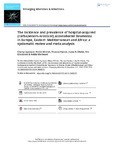The incidence and prevalence of hospital-acquired (carbapenem-resistant) Acinetobacter baumannii in Europe, Eastern Mediterranean and Africa: a systematic review and meta-analysis
Ayobami, Olaniyi
Willrich, Niklas
Harder, Thomas
Okeke, Iruka N.
Eckmanns, Tim
Markwart, Robby
Due to therapeutic challenges, hospital-acquired infections (HAIs) caused by Acinetobacter baumannii (HA-AB), particularly carbapenem-resistant strains (HA-CRAB) pose a serious health threat to patients worldwide. This systematic review sought to summarize recent data on the incidence and prevalence of HA-AB and HA-CRAB infections in the WHO-defined regions of Europe (EUR), Eastern Mediterranean (EMR) and Africa (AFR). A comprehensive literature search was performed using MEDLINE, EMBASE and GMI databases (01/2014-02/2019). Random-effects meta-analyses were performed to determine the pooled incidence of HA-AB and HA-CRAB infections as well as the proportions of A. baumannii among all HAIs. 24 studies from 3,340 records were included in this review (EUR: 16, EMR: 6, AFR: 2). The pooled estimates of incidence and incidence density of HA-AB infection in intensive care units (ICUs) were 56.5 (95% CI 33.9-92.8) cases per 1,000 patients and 4.4 (95% CI 2.9-6.6) cases per 1,000 patient days, respectively. Five studies conducted at a hospital-wide level or in specialized clinical departments/wards (ICU + non-ICU patients) showed HA-AB incidences between 0.85 and 5.6 cases per 1,000 patients. For carbapenem-resistant A. baumannii infections in ICUs, the pooled incidence and incidence density were 41.7 (95% CI 21.6-78.7) cases per 1,000 patients and 2.1 (95% CI 1.2-3.7) cases per 1,000 patient days, respectively. In ICUs, A. baumannii and carbapenem-resistant A. baumannii strains accounted for 20.9% (95% CI 16.5-26.2%) and 13.6% (95% CI 9.7-18.7%) of all HAIs, respectively. Our study highlights the persistent clinical significance of hospital-acquired A. baumannii infections in the studied WHO regions, particularly in ICUs.
Dateien zu dieser Publikation

